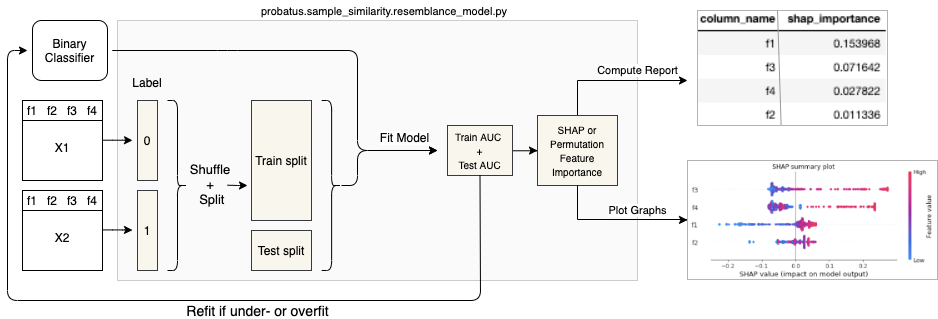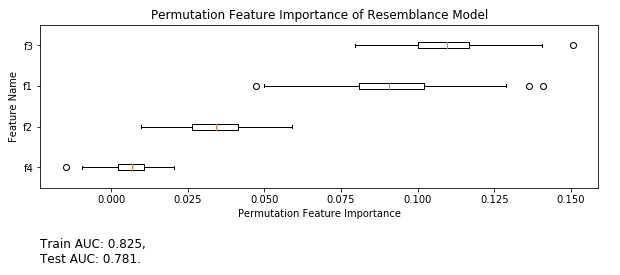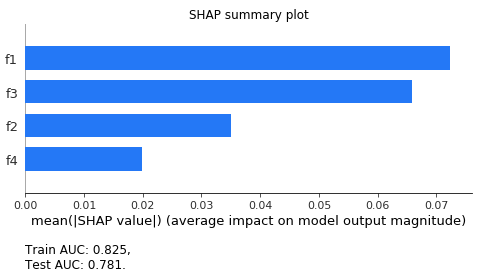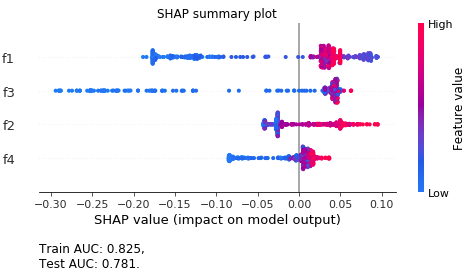Sample Similarity
The goal of sample similarity module is understanding how different two samples are from a multivariate perspective.
One of the ways to indicate this is Resemblance Model. Having two datasets - say X1 and X2 - one can analyse how easy it is to recognize which dataset a randomly selected row comes from. The Resemblance model assigns label 0 to the dataset X1, and label 1 to X2 and trains a binary classification model to predict which sample a given row comes from. By looking at the test AUC, one can conclude that the samples have a different distribution if the AUC is significantly higher than 0.5. Furthermore, by analysing feature importance one can understand which of the features have predictive power.

The following features are implemented:
- SHAPImportanceResemblance (Recommended): The class applies SHAP library, in order to interpret the tree based resemblance model.
- PermutationImportanceResemblance: The class applies permutation feature importance in order to understand which features the current model relies on the most. The higher the importance of the feature, the more a given feature possibly differs in X2 compared to X1. The importance indicates how much the test AUC drops if a given feature is permuted.
BaseResemblanceModel
Bases: BaseFitComputePlotClass
This model checks for the similarity of two samples.
A possible use case is analysis of whether th train sample differs from the test sample, due to e.g. non-stationarity.
This is a base class and needs to be extended by a fit() method, which implements how the data is split, how the model is trained and evaluated. Further, inheriting classes need to implement how feature importance should be indicated.
Source code in probatus/sample_similarity/resemblance_model.py
15 16 17 18 19 20 21 22 23 24 25 26 27 28 29 30 31 32 33 34 35 36 37 38 39 40 41 42 43 44 45 46 47 48 49 50 51 52 53 54 55 56 57 58 59 60 61 62 63 64 65 66 67 68 69 70 71 72 73 74 75 76 77 78 79 80 81 82 83 84 85 86 87 88 89 90 91 92 93 94 95 96 97 98 99 100 101 102 103 104 105 106 107 108 109 110 111 112 113 114 115 116 117 118 119 120 121 122 123 124 125 126 127 128 129 130 131 132 133 134 135 136 137 138 139 140 141 142 143 144 145 146 147 148 149 150 151 152 153 154 155 156 157 158 159 160 161 162 163 164 165 166 167 168 169 170 171 172 173 174 175 176 177 178 179 180 181 182 183 184 185 186 187 188 189 190 191 192 193 194 195 196 197 198 199 200 201 202 203 204 205 206 207 208 209 210 211 212 213 214 215 216 217 218 219 220 221 222 223 224 225 226 227 228 229 230 231 232 233 234 235 236 237 238 239 240 241 242 243 244 245 246 247 248 249 | |
__init__(model, scoring='roc_auc', test_prc=0.25, n_jobs=1, verbose=0, random_state=None)
Initializes the class.
Parameters:
| Name | Type | Description | Default |
|---|---|---|---|
model
|
model object
|
Regression or classification model or pipeline. |
required |
scoring
|
string or Scorer
|
Metric for which the model performance is calculated. It can be either a metric name aligned with predefined classification scorers names in sklearn. Another option is using probatus.utils.Scorer to define a custom metric. The recommended option for this class is 'roc_auc'. |
'roc_auc'
|
test_prc
|
float
|
Percentage of data used to test the model. By default 0.25 is set. |
0.25
|
n_jobs
|
int
|
Number of parallel executions. If -1 use all available cores. By default 1. |
1
|
verbose
|
int
|
Controls verbosity of the output:
|
0
|
random_state
|
int
|
Random state set at each round of feature elimination. If it is None, the results will not be reproducible and in random search at each iteration a different hyperparameters might be tested. For reproducible results set it to an integer. |
None
|
Source code in probatus/sample_similarity/resemblance_model.py
27 28 29 30 31 32 33 34 35 36 37 38 39 40 41 42 43 44 45 46 47 48 49 50 51 52 53 54 55 56 57 58 59 60 61 62 63 64 65 66 67 68 69 70 71 72 73 | |
compute(return_scores=False)
Checks if fit() method has been run and computes the output variables.
Parameters:
| Name | Type | Description | Default |
|---|---|---|---|
return_scores
|
bool
|
Flag indicating whether the method should return a tuple (feature importances, train score, test score), or feature importances. By default the second option is selected. |
False
|
Returns:
| Type | Description |
|---|---|
tuple(DataFrame, float, float) or DataFrame
|
Depending on value of return_tuple either returns a tuple (feature importances, train AUC, test AUC), or feature importances. |
Source code in probatus/sample_similarity/resemblance_model.py
181 182 183 184 185 186 187 188 189 190 191 192 193 194 195 196 197 198 199 200 | |
fit(X1, X2, column_names=None, class_names=None)
Base fit functionality that should be executed before each fit.
Parameters:
| Name | Type | Description | Default |
|---|---|---|---|
X1
|
ndarray or DataFrame
|
First sample to be compared. It needs to have the same number of columns as X2. |
required |
X2
|
ndarray or DataFrame
|
Second sample to be compared. It needs to have the same number of columns as X1. |
required |
column_names
|
list of str
|
List of feature names of the provided samples. If provided it will be used to overwrite the existing feature names. If not provided the existing feature names are used or default feature names are generated. |
None
|
class_names
|
None, or list of str
|
List of class names assigned, in this case provided samples e.g. ['sample1', 'sample2']. If none, the default ['First Sample', 'Second Sample'] are used. |
None
|
Returns:
| Type | Description |
|---|---|
BaseResemblanceModel
|
Fitted object |
Source code in probatus/sample_similarity/resemblance_model.py
87 88 89 90 91 92 93 94 95 96 97 98 99 100 101 102 103 104 105 106 107 108 109 110 111 112 113 114 115 116 117 118 119 120 121 122 123 124 125 126 127 128 129 130 131 132 133 134 135 136 137 138 139 140 141 142 143 144 145 146 147 148 149 150 151 152 153 154 155 156 157 158 159 160 161 162 163 164 165 166 167 168 | |
fit_compute(X1, X2, column_names=None, class_names=None, return_scores=False, **fit_kwargs)
Fits the resemblance model and computes the report regarding feature importance.
Parameters:
| Name | Type | Description | Default |
|---|---|---|---|
X1
|
ndarray or DataFrame
|
First sample to be compared. It needs to have the same number of columns as X2. |
required |
X2
|
ndarray or DataFrame
|
Second sample to be compared. It needs to have the same number of columns as X1. |
required |
column_names
|
list of str
|
List of feature names of the provided samples. If provided it will be used to overwrite the existing feature names. If not provided the existing feature names are used or default feature names are generated. |
None
|
class_names
|
None, or list of str
|
List of class names assigned, in this case provided samples e.g. ['sample1', 'sample2']. If none, the default ['First Sample', 'Second Sample'] are used. |
None
|
return_scores
|
bool
|
Flag indicating whether the method should return a tuple (feature importances, train score, test score), or feature importances. By default the second option is selected. |
False
|
**fit_kwargs
|
In case any other arguments are accepted by fit() method, they can be passed as keyword arguments. |
{}
|
Returns:
| Type | Description |
|---|---|
tuple of (pd.DataFrame, float, float) or pd.DataFrame
|
Depending on value of return_tuple either returns a tuple (feature importances, train AUC, test AUC), or feature importances. |
Source code in probatus/sample_similarity/resemblance_model.py
202 203 204 205 206 207 208 209 210 211 212 213 214 215 216 217 218 219 220 221 222 223 224 225 226 227 228 229 230 231 232 233 234 235 236 237 238 239 240 241 242 243 | |
get_data_splits()
Returns the data splits used to train the Resemblance model.
Returns:
| Type | Description |
|---|---|
(DataFrame, DataFrame, Series, Series)
|
X_train, X_test, y_train, y_test. |
Source code in probatus/sample_similarity/resemblance_model.py
170 171 172 173 174 175 176 177 178 179 | |
plot()
Plot.
Source code in probatus/sample_similarity/resemblance_model.py
245 246 247 248 249 | |
PermutationImportanceResemblance
Bases: BaseResemblanceModel
This model checks the similarity of two samples.
A possible use case is analysis of whether the train sample differs from the test sample, due to e.g. non-stationarity.
It assigns labels to each sample, 0 to the first sample, 1 to the second. Then, it randomly selects a portion of data to train on. The resulting model tries to distinguish which sample a given test row comes from. This provides insights on how distinguishable these samples are and which features contribute to that. The feature importance is calculated using permutation importance.
If the model achieves a test AUC significantly different than 0.5, it indicates that it is possible to distinguish between the samples, and therefore, the samples differ. Features with a high permutation importance contribute to that effect the most. Thus, their distribution might differ between two samples.
Examples:
from sklearn.datasets import make_classification
from sklearn.ensemble import RandomForestClassifier
from probatus.sample_similarity import PermutationImportanceResemblance
X1, _ = make_classification(n_samples=100, n_features=5)
X2, _ = make_classification(n_samples=100, n_features=5, shift=0.5)
model = RandomForestClassifier(max_depth=2)
perm = PermutationImportanceResemblance(model)
feature_importance = perm.fit_compute(X1, X2)
perm.plot()

Source code in probatus/sample_similarity/resemblance_model.py
252 253 254 255 256 257 258 259 260 261 262 263 264 265 266 267 268 269 270 271 272 273 274 275 276 277 278 279 280 281 282 283 284 285 286 287 288 289 290 291 292 293 294 295 296 297 298 299 300 301 302 303 304 305 306 307 308 309 310 311 312 313 314 315 316 317 318 319 320 321 322 323 324 325 326 327 328 329 330 331 332 333 334 335 336 337 338 339 340 341 342 343 344 345 346 347 348 349 350 351 352 353 354 355 356 357 358 359 360 361 362 363 364 365 366 367 368 369 370 371 372 373 374 375 376 377 378 379 380 381 382 383 384 385 386 387 388 389 390 391 392 393 394 395 396 397 398 399 400 401 402 403 404 405 406 407 408 409 410 411 412 413 414 415 416 417 418 419 420 421 422 423 424 425 426 427 428 429 430 431 432 433 434 435 436 437 438 439 440 441 442 443 444 445 446 447 448 449 450 451 452 453 454 455 456 457 458 459 460 461 462 463 464 465 466 467 468 469 470 471 472 473 474 475 476 477 478 479 | |
__init__(model, iterations=100, scoring='roc_auc', test_prc=0.25, n_jobs=1, verbose=0, random_state=None)
Initializes the class.
Parameters:
| Name | Type | Description | Default |
|---|---|---|---|
model
|
model object
|
Regression or classification model or pipeline. |
required |
iterations
|
int
|
Number of iterations performed to calculate permutation importance. By default 100 iterations per feature are done. |
100
|
scoring
|
string or Scorer
|
Metric for which the model performance is calculated. It can be either a metric name aligned with predefined classification scorers names in sklearn. Another option is using probatus.utils.Scorer to define a custom metric. Recommended option for this class is 'roc_auc'. |
'roc_auc'
|
test_prc
|
float
|
Percentage of data used to test the model. By default 0.25 is set. |
0.25
|
n_jobs
|
int
|
Number of parallel executions. If -1 use all available cores. By default 1. |
1
|
verbose
|
int
|
Controls verbosity of the output:
|
0
|
random_state
|
int
|
Random state set at each round of feature elimination. If it is None, the results will not be reproducible and in random search at each iteration a different hyperparameters might be tested. For reproducible results set it to integer. |
None
|
Source code in probatus/sample_similarity/resemblance_model.py
284 285 286 287 288 289 290 291 292 293 294 295 296 297 298 299 300 301 302 303 304 305 306 307 308 309 310 311 312 313 314 315 316 317 318 319 320 321 322 323 324 325 326 327 328 329 330 331 332 333 334 335 336 337 338 339 340 341 342 343 344 345 346 | |
fit(X1, X2, column_names=None, class_names=None)
This function assigns labels to each sample, 0 to the first sample, 1 to the second.
Then, it randomly selects a portion of data to train on. The resulting model tries to distinguish which sample a given test row comes from. This provides insights on how distinguishable these samples are and which features contribute to that. The feature importance is calculated using permutation importance.
Parameters:
| Name | Type | Description | Default |
|---|---|---|---|
X1
|
ndarray or DataFrame
|
First sample to be compared. It needs to have the same number of columns as X2. |
required |
X2
|
ndarray or DataFrame
|
Second sample to be compared. It needs to have the same number of columns as X1. |
required |
column_names
|
list of str
|
List of feature names of the provided samples. If provided it will be used to overwrite the existing feature names. If not provided the existing feature names are used or default feature names are generated. |
None
|
class_names
|
None, or list of str
|
List of class names assigned, in this case provided samples e.g. ['sample1', 'sample2']. If none, the default ['First Sample', 'Second Sample'] are used. |
None
|
Returns:
| Type | Description |
|---|---|
PermutationImportanceResemblance
|
Fitted object. |
Source code in probatus/sample_similarity/resemblance_model.py
348 349 350 351 352 353 354 355 356 357 358 359 360 361 362 363 364 365 366 367 368 369 370 371 372 373 374 375 376 377 378 379 380 381 382 383 384 385 386 387 388 389 390 391 392 393 394 395 396 397 398 399 400 401 402 403 404 405 406 407 408 409 410 411 412 413 414 415 416 | |
plot(ax=None, top_n=None, show=True, **plot_kwargs)
Plots the resulting AUC of the model as well as the feature importances.
Parameters:
| Name | Type | Description | Default |
|---|---|---|---|
ax
|
axes
|
Axes to which the output should be plotted. If not provided new axes are created. |
None
|
top_n
|
int
|
Number of the most important features to be plotted. By default features are included in the plot. |
None
|
show
|
bool
|
If True, the plots are shown to the user, otherwise they are not shown. Not showing a plot can be useful when you want to edit the returned axis before showing it. |
True
|
**plot_kwargs
|
Keyword arguments passed to the matplotlib.plotly.subplots method. |
{}
|
Returns:
| Type | Description |
|---|---|
axes
|
Axes that include the plot. |
Source code in probatus/sample_similarity/resemblance_model.py
418 419 420 421 422 423 424 425 426 427 428 429 430 431 432 433 434 435 436 437 438 439 440 441 442 443 444 445 446 447 448 449 450 451 452 453 454 455 456 457 458 459 460 461 462 463 464 465 466 467 468 469 470 471 472 473 474 475 476 477 478 479 | |
SHAPImportanceResemblance
Bases: BaseResemblanceModel
This model checks for similarity of two samples.
A possible use case is analysis of whether the train sample differs from the test sample, due to e.g. non-stationarity.
It assigns labels to each sample, 0 to the first sample, 1 to the second. Then, it randomly selects a portion of data to train on. The resulting model tries to distinguish which sample a given test row comes from. This provides insights on how distinguishable these samples are and which features contribute to that. The feature importance is calculated using SHAP feature importance.
If the model achieves test AUC significantly different than 0.5, it indicates that it is possible to distinguish between the samples, and therefore, the samples differ. Features with a high permutation importance contribute to that effect the most. Thus, their distribution might differ between two samples.
This class currently works only with the Tree based models.
Examples:
from sklearn.datasets import make_classification
from sklearn.ensemble import RandomForestClassifier
from probatus.sample_similarity import SHAPImportanceResemblance
X1, _ = make_classification(n_samples=100, n_features=5)
X2, _ = make_classification(n_samples=100, n_features=5, shift=0.5)
model = RandomForestClassifier(max_depth=2)
rm = SHAPImportanceResemblance(model)
feature_importance = rm.fit_compute(X1, X2)
rm.plot()


Source code in probatus/sample_similarity/resemblance_model.py
482 483 484 485 486 487 488 489 490 491 492 493 494 495 496 497 498 499 500 501 502 503 504 505 506 507 508 509 510 511 512 513 514 515 516 517 518 519 520 521 522 523 524 525 526 527 528 529 530 531 532 533 534 535 536 537 538 539 540 541 542 543 544 545 546 547 548 549 550 551 552 553 554 555 556 557 558 559 560 561 562 563 564 565 566 567 568 569 570 571 572 573 574 575 576 577 578 579 580 581 582 583 584 585 586 587 588 589 590 591 592 593 594 595 596 597 598 599 600 601 602 603 604 605 606 607 608 609 610 611 612 613 614 615 616 617 618 619 620 621 622 623 624 625 626 627 628 629 630 631 632 633 634 635 636 637 638 639 640 641 642 643 644 645 646 647 648 649 650 651 652 653 654 655 656 657 658 659 660 661 662 663 664 665 666 667 668 669 670 671 672 673 | |
__init__(model, scoring='roc_auc', test_prc=0.25, n_jobs=1, verbose=0, random_state=None)
Initializes the class.
Parameters:
| Name | Type | Description | Default |
|---|---|---|---|
model
|
model object
|
Regression or classification model or pipeline. |
required |
scoring
|
string or Scorer
|
Metric for which the model performance is calculated. It can be either a metric name aligned with predefined classification scorers names in sklearn. Another option is using probatus.utils.Scorer to define a custom metric. Recommended option for this class is 'roc_auc'. |
'roc_auc'
|
test_prc
|
float
|
Percentage of data used to test the model. By default 0.25 is set. |
0.25
|
n_jobs
|
int
|
Number of parallel executions. If -1 use all available cores. By default 1. |
1
|
verbose
|
int
|
Controls verbosity of the output:
|
0
|
random_state
|
int
|
Random state set at each round of feature elimination. If it is None, the results will not be reproducible and in random search at each iteration a different hyperparameters might be tested. For reproducible results set it to integer. |
None
|
Source code in probatus/sample_similarity/resemblance_model.py
517 518 519 520 521 522 523 524 525 526 527 528 529 530 531 532 533 534 535 536 537 538 539 540 541 542 543 544 545 546 547 548 549 550 551 552 553 554 555 556 557 558 559 560 561 562 563 564 565 566 567 | |
fit(X1, X2, column_names=None, class_names=None, **shap_kwargs)
This function assigns labels to each sample, 0 to the first sample, 1 to the second.
Then, it randomly selects a portion of data to train on. The resulting model tries to distinguish which sample a given test row comes from. This provides insights on how distinguishable these samples are and which features contribute to that. The feature importance is calculated using SHAP feature importance.
Parameters:
| Name | Type | Description | Default |
|---|---|---|---|
X1
|
ndarray or DataFrame
|
First sample to be compared. It needs to have the same number of columns as X2. |
required |
X2
|
ndarray or DataFrame
|
Second sample to be compared. It needs to have the same number of columns as X1. |
required |
column_names
|
list of str
|
List of feature names of the provided samples. If provided it will be used to overwrite the existing feature names. If not provided the existing feature names are used or default feature names are generated. |
None
|
class_names
|
None, or list of str
|
List of class names assigned, in this case provided samples e.g. ['sample1', 'sample2']. If none, the default ['First Sample', 'Second Sample'] are used. |
None
|
**shap_kwargs
|
keyword arguments passed to
shap.Explainer.
It also enables |
{}
|
Returns:
| Type | Description |
|---|---|
SHAPImportanceResemblance
|
Fitted object. |
Source code in probatus/sample_similarity/resemblance_model.py
569 570 571 572 573 574 575 576 577 578 579 580 581 582 583 584 585 586 587 588 589 590 591 592 593 594 595 596 597 598 599 600 601 602 603 604 605 606 607 608 609 610 611 | |
get_shap_values()
Gets the SHAP values generated on the test set.
Returns:
| Type | Description |
|---|---|
array
|
SHAP values generated on the test set. |
Source code in probatus/sample_similarity/resemblance_model.py
664 665 666 667 668 669 670 671 672 673 | |
plot(plot_type='bar', show=True, **summary_plot_kwargs)
Plots the resulting AUC of the model as well as the feature importances.
Parameters:
| Name | Type | Description | Default |
|---|---|---|---|
plot_type
|
str
|
Type of plot, used to compute shap.summary_plot. By default 'bar', available ones are "dot", "bar", "violin", |
'bar'
|
show
|
bool
|
If True, the plots are showed to the user, otherwise they are not shown. Not showing plot can be useful, when you want to edit the returned axis, before showing it. |
True
|
**summary_plot_kwargs
|
kwargs passed to the shap.summary_plot. |
{}
|
Returns:
| Type | Description |
|---|---|
axes
|
Axes that include the plot. |
Source code in probatus/sample_similarity/resemblance_model.py
613 614 615 616 617 618 619 620 621 622 623 624 625 626 627 628 629 630 631 632 633 634 635 636 637 638 639 640 641 642 643 644 645 646 647 648 649 650 651 652 653 654 655 656 657 658 659 660 661 662 | |